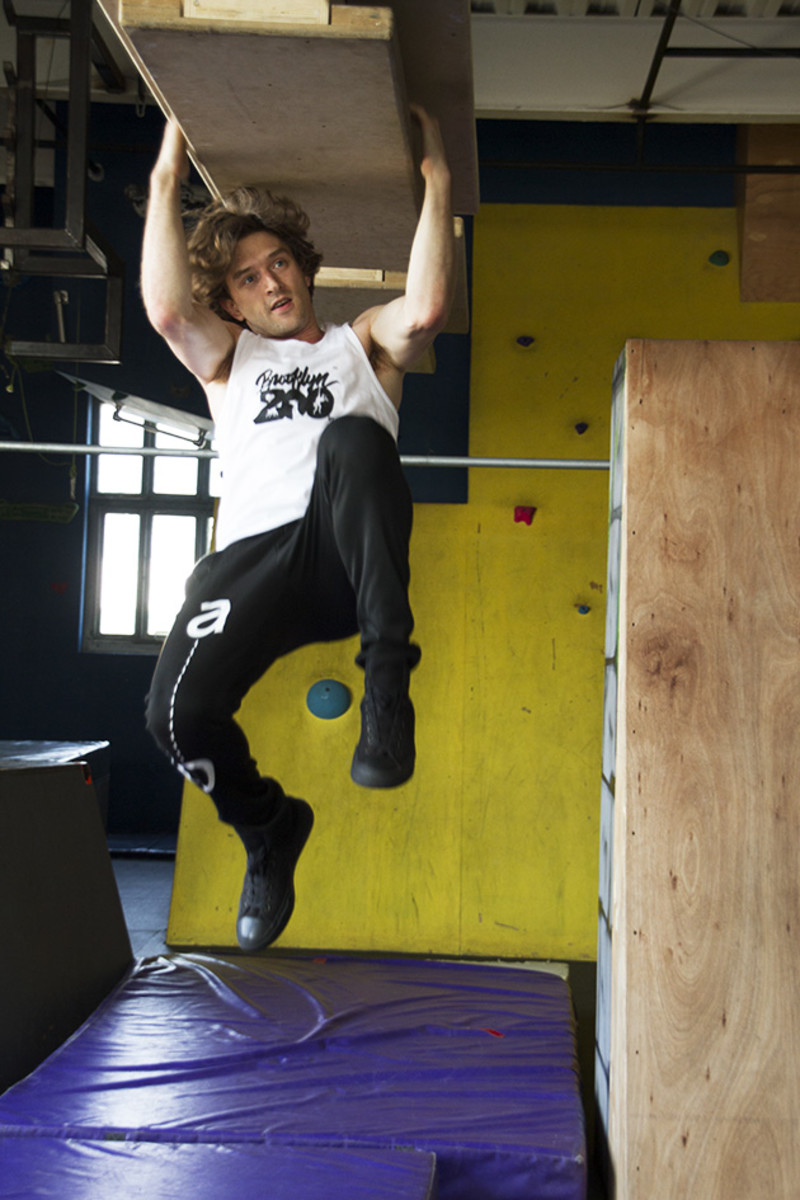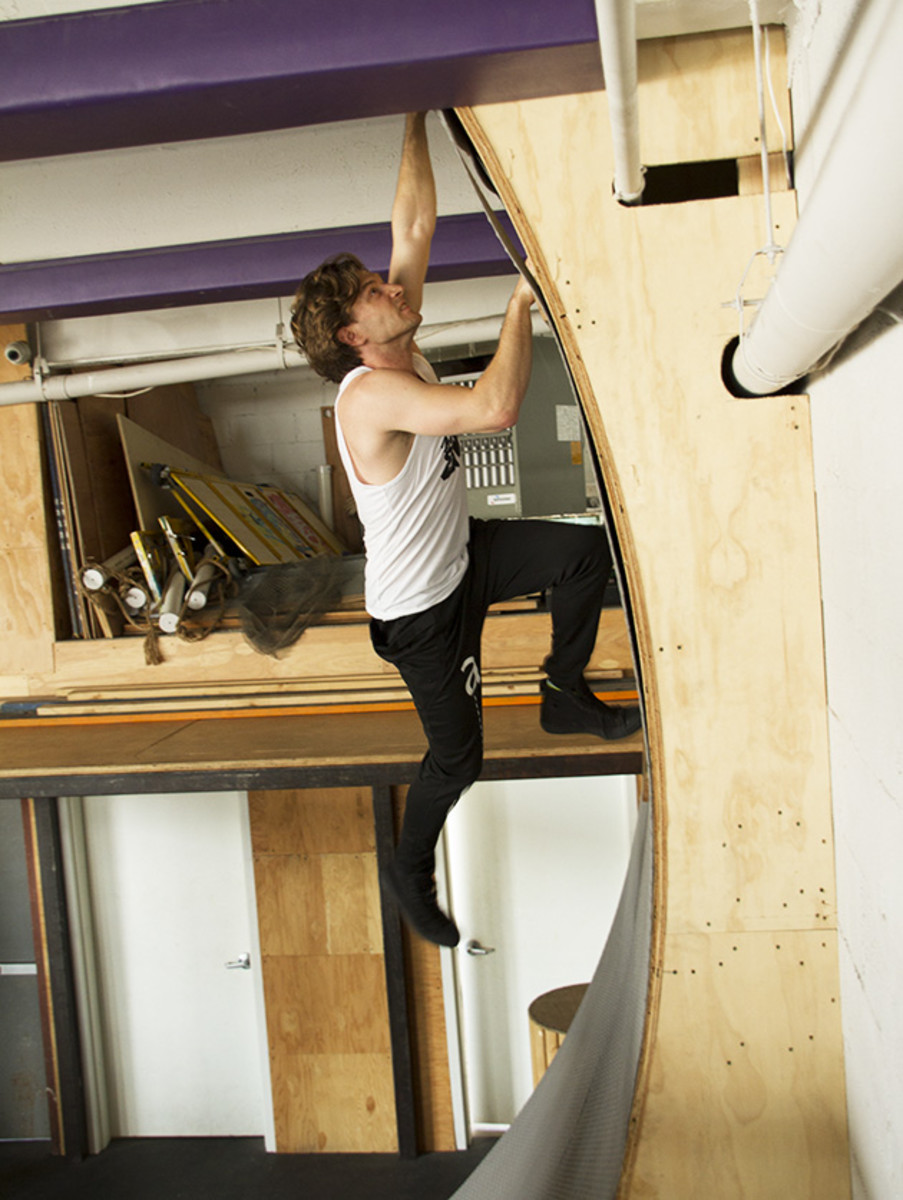The rise of American Ninja Warrior gyms and ninja-style training

Nate Aye’s Chicago gym was in transition. It was 2012, and after three years, he has decided to drop his CrossFit license. He still loves powerlifting, though, and wants to rebrand his 2,400 square feet as a strength club. He already has the barbells, bumper plates, and cushioned floors, but on this day, he was working on something new, something he saw a few months earlier when he competed on the American version of a Japanese show he’d been watching since 2005. He didn’t have any blueprints, just a vague sense of the dimensions, the general shape, and his dad, a carpenter of 40 years. Before they started construction, the two sketched the design with a protractor and compass.
SI’s Fittest 50: The CrossFit athletes
Five days and $600 later, they had finished a replica of the Warped Wall, the final obstacle on every American Ninja Warrior qualifying course since the show premiered in 2009. Aye says he could’ve finished in half the time, “but my dad was getting on in age a little bit and didn’t move that fast.” The wall was an instant hit with Aye’s “ninja nerds,” a small group of guys who got together once or twice a month to fool around. They would practice bar-to-bar transfers, balance on PVC pipes, and use mats to construct make-shift Quintuple Steps. This, however, was their first real obstacle on which to practice, and when that first ninja made it up the 14-foot curve, hung from the top, and pulled himself up, whatever direction Aye had planned for his gym was irrelevant.
In less than a year, the Golden Age Strength Club became the Chicago Ninja Academy. One of the only places in the area to train on actual obstacles from the show, the gym attracted serious competitors, such as Brandon Mears and Dan Polizzi, who have competed as the Towers of Power on both the show and its spinoff, Team Ninja Warrior. The Towers built the Salmon Ladder, on which I trained before competing on the sixth season, along with dozens of other obstacles, and the gym expanded to accommodate. In four years, Chicago Ninja Academy more than quadrupled in size to almost 11,000 square feet (a little smaller than an Olympic swimming pool). Today, the powerlifting equipment sits in an adjacent warehouse, a negligible part of Aye’s business, more a “labor of love” than anything else.

Aye’s clientele has also grown, thanks in part to the unusual structure of the show. Last season, 40,000 hopefuls applied for 800 spots. After being rejected, hundreds then waited for up to 10 days for the slim chance of being picked as a walk-on. Many contestants on the show—save those who become audience favorites—are not called back the following year even if they perform well, and ninjas who are accepted find out no more than four weeks before the competition. Still, they must start preparing well before then. The result is a large pool of devoted ninjas who want to train year-round.
What it will take to run a sub-two-hour marathon
In the beginning, it was the hardcore elite, like the Towers, who followed the show, built the obstacles, and transformed ninja training from oddity to institution—but they’re now in the minority, along with another key demographic: the Instagram Bros, who see the show and think, “Why the hell not?” They show up at Chicago Ninja Academy and walk straight to one of two obstacles, the Warped Wall or the Salmon Ladder. Aye can barely get them to sign a waiver before they take a picture, run halfway up the Wall, biff it, and leave.
Today, the majority of people doing obstacle training are fit, but not exceptionally so, and go to class once or twice a week. Their athletic backgrounds are diverse—mostly gymnastics, dance, and cheer for the women; parkour and climbing for the men—and they also train at conventional gyms. They’re dedicated but not fanatic, which is part of the reason why CNA expanded so quickly. “When the obstacles are all mashed together, it appeals to the people who know what they’re doing,” Aye says. That’s fine when it’s just the ninja nerds, but “then you’re a coach of super competitive athletes, as opposed to having a strong business in the gym world.”
Aye has also tailored his curriculum based on another key shift: Unlike the Towers of Power, this latest wave of ninjas isn’t necessarily training to be on the show that inspired their workouts. Of the 60 regulars at Chicago Ninja Academy, only 20 sent in applications this year, a rate that was similar at other gyms that offer ninja classes. Robin Friend Stift, the manager at New York City’s Brooklyn Zoo, and Glenn Davis, co-founder of Ninja Quest in Georgia, say only half their adults applied. What used to be a zany item on gym rats’ bucket lists has become another way for amateur athletes to test their fitness.

Likewise, ninja academies are no longer the only gyms that offer obstacle training. In 2014, half the curriculum at Brooklyn Zoo was parkour. The rest was split between tumbling, tricking, capoeira, aerial silks, breakdancing, and handstands. Since parkour entails similar movements to those of ninja training, the gym decided to throw a ninja competition, but since they had few obstacles, not even a Warped Wall, they contracted with Justin Conway, a former ANW competitor who had started designing obstacle courses. At 7:00 p.m. the night before the competition, Conway and his crew started rigging the gym. They finished around two in the morning, slept, and were back six hours later.
Training with Scott Dixon: Racer reaps triathlon benefits in IndyCar
Conway and Stift divided the day into four two-hour slots, one for kids, one for teens, and two for adults. Unlike the show, on which athletes are prohibited from testing the course beforehand, Brooklyn Zoo allowed competitors to spend the first hour practicing and the second hour competing. Not only did all the competition slots fill, but breaking down the course was also much easier than assembling it. By the time Conway awarded prizes to the top three finishers, Brooklyn Zoo had become a parkour gym again. Ever since, the gym has hosted a competition every two months, including a National Ninja League qualifier, which attracted athletes from as far away as California.
Regardless of whether gym owners want to create ninja academies or offer occasional competitions, they no longer have to sketch their Warped Walls with protractors and compasses. Not only are former competitors such as Conway acting as course consultants, but hundreds of blueprints are also available on Pinterest. The rise of obstacle training, however, is about much more than the physical architecture. For Nate Aye, the pattern is familiar: An underground, jargon-laden quasi-sport that amasses a following of hardcore disciples and then becomes a part of mainstream fitness culture. The way he puts it: “It might be the next CrossFit.”
